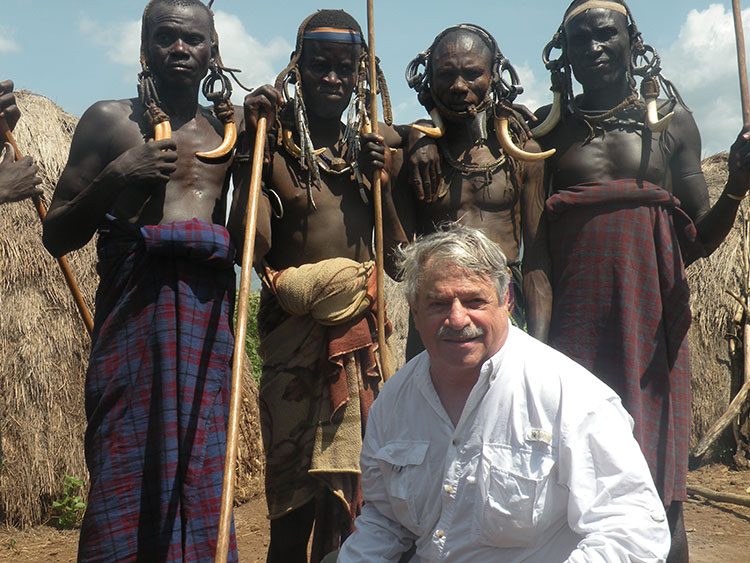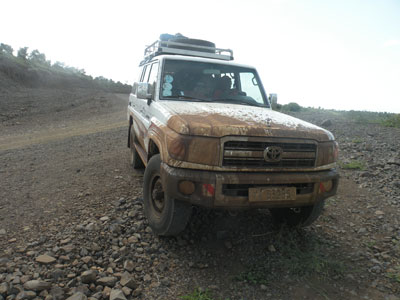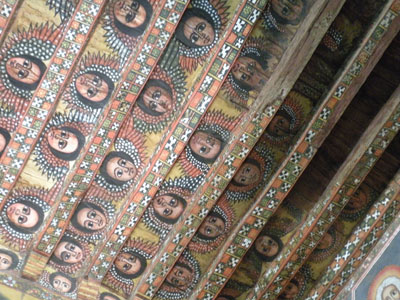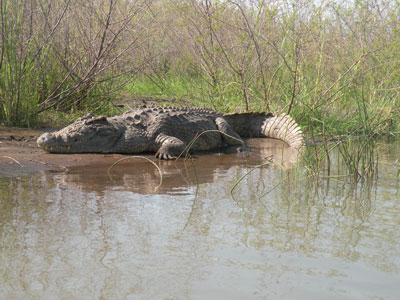Addis Ababa and the extraordinary tribes of the Omo Valley — a private tour of Ethiopia
This article appears on page 6 of the June 2013 issue.
by Larry Kritcher; Coconut Grove, FL
Located south of Sudan and bordered by Eritrea, Somalia, Djibouti, South Sudan and Kenya, Ethiopia is an explorer’s gemstone.
Ethiopia is the mother of the Blue Nile, which drops out of Lake Tana, high in the Semien Mountains, flowing through Sudan to the confluence of the White Nile at Khartoum. It then wends its way through the blinding Sahara Desert and the old Nubian lands over the cataracts in Egypt, continuing through the ancient Land of Goshen and, finally, emptying into the Mediterranean Sea at Alexandria.
From an airplane, the two Niles are plainly visible as they form green, fertile valleys amid the stark, sandy countries they flow through. At night, the band of lights formed by the populations that thrive along their waters are visible as far as the eye can see, amid millions of square miles of darkness.
Making plans
Ethiopia is about 9 degrees north of the equator, so one might think it would be relatively warm. Not so! There are few places in the country where the elevation is under 2,000 feet.
The cooler, mountainous terrain helped spawn Ethiopia’s number-one export, coffee, whose original home was in the region of Kaffa.
Many people would never put Ethiopia on their travel horizon. My wife, Rita, and I did because its various cultures interested us, and many of the well-seasoned and adventurous travelers we met on our trips to Papua New Guinea and elsewhere gave it a “thumbs up” on their lists of places to experience. We were convinced.
I bought several older guidebooks on Ethiopia, as current ones were hard to find. We finally purchased the newest Bradt Travel Guide, which appeared in September ’12, but it was too late to use for most of our planning.
Using each book’s list of Ethiopian tour operators, I sent each company an email stating what we would like to do and see.
The more I read, the more fascinated I became with the Omo Valley and its tribes near the Kenyan border. Fascination turned to intrigue when I saw pictures of Mursi women with clay discs in their lower lips. The body painting, scarification and hair styles expressed their colorful style.
Would we go almost 10,000 miles to see only this? Yes, we would. But we would also add the historic route from Addis Ababa north to Gondar, the scenic Semien Mountains to Axum (the reported home of the Ark of the Covenant) near the Eritrean border, and the rock-hewn churches of Lalibela.
Various tour companies responded to my inquiry — 19, to be exact. I wrote to the department of tourism in the capital, Addis Ababa, to verify their authenticity, and I read the online feedback on TripAdvisor, Kayak and other travel information websites. I also looked to my saved issues of International Travel News to see what others had to say about this region.
From my research, it seemed that the number of tourist sites is somewhat limited in Ethiopia. However, they are so worthwhile that UNESCO has eight areas listed as World Heritage Sites. Of those, we would see six.
Choosing an operator
After a rigid background check, we found Rainbow Exclusive Car Rental & Tour Services PLC (Addis Ababa) to be to our liking. This is an Ethiopian company, not to be confused with the one in London of a similar name.
‘Why use a local tour company?’ one might ask. I always think it is better for the people we visit. It helps to raise spirits and self esteem, boost the economy and promote a better relationship between our countries. Showing respect for other cultures has benefits on both sides.
The danger is obvious, in that it is difficult to find recompense if the details go wrong. Things could really get nasty if someone is not on the up-and-up when you wire thousands of dollars to a foreign bank account. However, it has been our experience that local companies also charge about half as much as US companies, but your homework has to be thorough.
For a visit to Ethiopia, having an agent arrange hotel rooms, entrance fees and local guides is a necessity unless you speak Amharic, the native tongue.
This, I emphasize, is not like a trip to Europe, where you rent a car and just amble about. Hotels are few and far between, and rough roads require 4x4 vehicles with a couple of spare tires and jerry cans of fuel.
Then it was time to update our vaccinations. We received a full litany of shots to immunize us against almost everything. We purchased an emergency-medical-evacuation insurance policy ($456) through Allianz Travel Insurance (phone 866/884-3556) so we could get private jet transportation to Europe, if necessary. It also covered lost bags, trip interruption, trip cancellation, etc.
Our international airfare to and from Ethiopia was a separate purchase.
We negotiated a tour package with Rainbow that included domestic airfares, transfers, boat services and the best hotels and lodges in the areas to be visited. Three-star hotel ratings were about the best most areas could provide. Also included were a tour guide, driver and scout/guard plus room and board.
The total price was $5,206 ($2,603 per person). We sent half up front so flights and rooms could be reserved and paid the other half on arrival.
With the wire transfer made, we were set to go to this corner of the Earth, with promised VIP treatment. All that was left was the packing. It would be hot at times near sea level and cold in the high mountains, so we packed accordingly.
Getting there
We would get our visas at our entry airport, Bole International in Addis Ababa. Our route would take us on United Airlines from Miami to Washington, DC, to Frankfurt, arriving at 7 a.m. to make an 11 a.m. connection on Lufthansa to Addis Ababa via Khartoum, Sudan, arriving at 9 p.m. Rainbow would meet our inbound flight at Customs. All seemed in order for our October ’12 journey to Africa.
About three weeks before departure, the news came out that the German Embassy in Khartoum was under siege by protesters and rioters. It was burned and suffered extensive damage.
Our plane was stopping there and — guess what? — we would be on Lufthansa, the German national airline. A US State Department warning went up that Sudan was to be avoided.
As it turned out (with the travel fairies stroking us for good luck), our plane went through Khartoum both ways without a hitch.
On our Friday-evening arrival in Addis Ababa, we got our visas and retrieved our lone checked bag and there he was, Fasil, our trusty young Rainbow tour guide for the next 16 days.
With smiles and salutations, we were whisked away by our driver, Raphael, to the Radisson Blu Hotel in central Addis Ababa. It was a new hotel with every amenity possible, making it easy for us to gather our thoughts and reenergize from our long journey of over 32 hours (18 hours of flight).
On the road
I had purposely scheduled a day of rest, so we began our drive on Sunday morning. Heading south in our 4x4 Land Cruiser, we knew we were blessed with a departure on this day of the week. The normal truck parade we were told to expect was absent, with only a handful of diesel monsters roaring around belching black smoke.
As we exited the city limits on the 2-lane roadway, we sped past streets of shabby, unpainted mom-and-pop shacks selling everything imaginable.
The infrastructure there is nearly nonexistent. Water is hand carried, cooking is done on roadside fires, there is limited electricity, mud alleys are lined with refuse, and broken-down discards are everywhere.
As the city thinned into more rural surroundings, our 2-way artery had detours, and the road, itself, had patches of asphalt interspersed with miles of gravel and rutted roads. The highway turned to a byway with increasing numbers of livestock being driven by children as young as four or five.
The farther south we went, the more we descended out of the mountainous terrain into the lower levels of the Great Rift Valley, studded with lakes and weekend cottages for the more prosperous people of the capital.
We rattled and bumped our way down the road, Raphael honking the horn at most everything that moved, announcing our passage. The voracious flies seemed unbothered by the altitude.
Upon reaching Lake Langano, we stayed at the Sabana Beach Resort (a most unusual name for this part of the world), which was quite comfortable and attractive. Well-maintained cabins surrounded a central lodge that overlooked the lake.
There we had our first taste of Ethiopian cuisine, with injera, the ubiquitous flatbread. Spongy and pliable, it was pinched off and eaten with one’s fingers after wrapping it around bites of the main dish, usually a spicy stew.
For less adventurous food eaters, an alternate choice was pasta. When the Italians tried to colonize the country in the mid 1930s, they brought with them their wonderful cuisine. When Rita found this out, she was in food heaven.
There was also an abundance of fruits and fresh vegetables, which are on most travelers’ no-no lists. We sparingly indulged, knowing we had a healthy supply of Cipro, Levaquin and Imodium on hand.
Since Ethiopian wines are scarce and somewhat intolerable, we drank South African vintages, which we found most everywhere. Another cheer from Rita! Bottled water was readily available as well.
Arba Minch
The following day, we headed toward Arba Minch, a hub city in the south. Our first stop was the colorful market at Chencha, a village of the Dorze tribe, whose members walked for miles to buy and sell basic necessities.
As with all markets, it is also a social event, a chance to catch up on news and views. This is where we learned photo-op etiquette. After permission to snap is granted, you must offer the requisite and very specific amount of payment per picture: five birr (30¢) for adults, three for children, two for babies. Don’t try to cheat; they count the shutter clicks.
After our visit, we had a tasty lunch at the Paradise Lodge on the edge of an escarpment overlooking Lake Chamo in Arba Minch, happily knowing this would be one of our lodges on a forthcoming night.
We continued our drive, with the roads getting bumpier, absent of paving. Sometimes we inched along, taking several hours or more to drive a mere 100 kilometers. The livestock herds were now numbering 50-plus, taking their toll on the clock, if anyone was keeping time.
That night we stayed at the neon-green Kanta Lodge in the village of Karat Konso — not quite as impressive as the lodging the night before but certainly acceptable. This was the home of one of the largest tribes in southern Ethiopia, the Konso.
Omo Valley tribes
Day five would take us toward the Kenyan border, deeper into the Omo Valley. The Hamer people are the boss tribe there, with an estimated 45,000 members.
En route, we stopped at the Dimeka market, where we saw the Hamer, Bana and Karo people, who gave great meaning to tribal distinction and attitude.
Self assured, they were adorned with as many beads and metal bits as their status allowed. Cowry shells seemed plentiful and were used to make waist ties and necklaces.
Bodies were slathered with copper-colored clay from top to bottom, and hair plaits got special attention with rancid butter, which glowed in the sun. Phew!
If there are no puddles to rinse off in, bathing is done with dust or, if lucky, a mud bath — not exactly the kind you get at your local spa.
Our home for the next two nights was the Buska Lodge, which came complete with mosquito netting and electricity from 6 to 10 both morning and night. From there, we proceeded to Murielle, home of the Karo and deep in the southern Omo Valley.
This tribe’s numbers are diminishing — presently fewer than 5,000. They are masters of body painting, frequently imitating the colorful, spotted plumage of the guinea fowl. White chalk, red clay, charcoal and other coloring materials are used to create designs, and flowers, branches, leaves and ostrich feathers decorate the body along with metal neck rings.
Earrings are created from found items of all sorts, including bottle caps and pieces of cattle horn. They are some of the most ornamented people on the African continent.
Regretfully, we missed the famous Hamer bull-jumping ceremony, since the walking distance was too great. This is a coming-of-age ritual in which a young man must prove his physical prowess by jumping over the backs of up to seven bulls, thus making himself eligible to choose a bride.
To compensate, we made a stop at an impeccably kept Hamer village encircled by a uniquely woven bramble kraal, which kept the livestock in and the predators out. The round mud-and-stick huts, called tukuls, were approximately 20 feet in diameter, each with a 3-foot-high entrance and no windows. The conical roofs were thatched, the floor was dirt, and the atmosphere inside was dim and heavy with pungent campfire smoke. (Termites shy away from smoke.)
Our local guide lived in this village, and we were privileged to be welcomed into his family home. The only sign of the “new” world was the ever-present dented metal teapot.
Another 140 kilometers later we reached the market at Key Afar, which, again, illustrated the variety in tribal customs, this time from the Ari, Bana and Tsemay people. For its plethora of primitive Omo art, this Thursday market is most popular with tour operators.
The next two nights’ accommodations overlooked a peaceful valley near Jinka. To our surprise, the 3-star Eco-Omo Safari Lodge consisted of large permanent tents with bathrooms attached. As night descended, so did the dampness. The sounds of the village below rose with the smell of the ubiquitous cooking-fire smoke. No snakes or rodents penetrated the towels that we stuffed into the gap under our door.
Mursi visit
A communication gap occurred the next morning when we explained that, because of a rumbling tummy, we wanted to visit the Mursi tribe but skip the rest of that day’s tour at the Jinka Museum and continue back to the Paradise Lodge in Arba Minch, where we would be more comfortable than in a tent. This got mistranslated, and as we passed Key Afar I realized we were heading in the wrong direction. Raphael turned around and the 80-kilometer error was corrected.
We drove another 75 kilometers west of Jinka through beautifully wooded terrain and across the Mago River. The land was terraced, showing off their intricate farming techniques.
We came to the land of the Mursi, where the women have the custom of incising their lower lips, inserting a small clay disk in the cut. As they grow older, the plate is enlarged and eventually can measure up to five to size inches in diameter. They do the same with their earlobes but to a smaller degree. This mark of beauty enhances their dowry for marriage.
Some anthropologists say that when the plate is removed, the body is rendered “ugly,” making them safe from slave traders. Others say that the plate prevents evil spirits from crawling into their mouths. At any rate, this most spectacular tradition eclipsed even the painted bodies of the Karo.
Our village interaction was “up close and personal” and the photography session well orchestrated, thanks to local guide Tsefaye’s language and crowd-control skills.
Since it was getting too late to set out for Arba Minch, our tent awaited our return with open flaps. Night driving is said to be dangerous and is not encouraged. (Rainbow, in fact, prohibits it.)
Lake Chamo
When I was planning this adventure, Lake Chamo was central to many suggestions. It was particularly flagged as a birder’s paradise, bound to offer up many rare species. Secondarily, it was noted for its vast number of crocodiles.
Near Arba Minch, we went boating for a couple of hours on this large and beautiful lake, which was teeming with the promised bird life and behemoth crocodiles. At upwards of 600 kilos each and measuring 15 to 20 feet in length, they were the largest crocs we had ever seen.
On our return to the dock, we saw men fishing, diving into the croc-infested water with small reed spears — something I would not be willing to do.
Our first internal flight back to Addis Ababa went without a hitch, and the following morning we flew north to Gondar, one of Ethiopia’s three former capitals. This was the beginning of the second half of our journey, traveling the historic northern route. It certainly would prove to be historic to us in more ways than one.
Next month, the journey continues.




